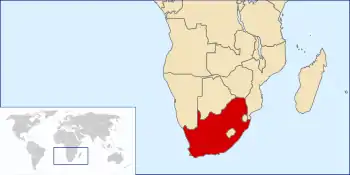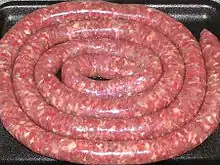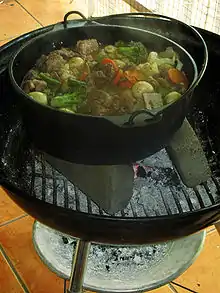South African cuisine
South African cuisine reflects the diverse range of culinary traditions embodied by the various communities that inhabit the country. Among the indigenous peoples of South Africa, the Khoisan foraged over 300 species of edible food plants,[1] such as the rooibos shrub legume,[2] whose culinary value continues to exert a salient influence on South African cuisine. Subsequent encounters with Bantu pastoralists facilitated the emergence of cultivated crops and domestic cattle, which supplemented traditional Khoisan techniques of meat preservation.[3] In addition, Bantu-speaking communities forged an extensive repertoire of culinary ingredients and dishes, many of which are still consumed today in traditional settlements and urban entrepôts alike. By the seventeenth century, Dutch and British foodways brought via European immigration resulted in further culinary diffusion. Cape Coloured and Cape Malay communities founded a distinctive diasporic cuisine, derived largely from Malaysian and Indonesian culinary traditions, while Afrikaner voortrekkers further inland adapted Dutch, Khoisan, Cape Malay and Bantu foodways to accommodate their peripatetic lifestyle. In addition, French Huguenot refugees, many of whom settled in Franschhoek, played an instrumental role in developing South Africa's viticultural industry.
| Part of a series on the |
| Culture of South Africa |
|---|
 |
| History |
| People |
| Cuisine |
| Religion |
| Art |
| Sport |
|

During the period of British colonial rule, immigrants from Asia, many of whom arrived as indentured laborers in the nineteenth century, further enriched the culinary oeuvre of South Africa. In particular, Indian South Africans - and, to some extent, Chinese South Africans - brought a wealth of spices, seasonings and dishes, historically associated with Kwa-Zulu Natal, although Indian cuisine is currently widely available across South Africa and consumed by all ethnic groups.
As oppression, violence and poverty festered in South Africa during apartheid, disinvestments and sanctions further stifled the country's culinary output. However, shebeens situated in urban townships served as loci of solidarity and resistance, especially for black South Africans who pursued their cultural and culinary traditions to preserve their heritage and cultivate community ties. Following the end of apartheid, South African cuisine witnessed a renaissance, with diverse culinary options available in most of the country's major cities catering to tourists, expatriates and locals alike. In addition, South African ingredients and dishes have attained greater visibility worldwide, owing to the growing economic and cultural clout of the country, coupled with the burgeoning South African diaspora.
Indigenous cookery
In the precolonial period, indigenous cuisine was characterised by the use of a very wide range of foods including fruits, nuts, bulbs, leaves and other products gathered from wild plants and by the hunting of wild game. The introduction of domestic cattle and grain crops by Bantu speakers who arrived in the southern regions from central Africa since 10,000 BC and the spread of cattle keeping to Khoisan groups enabled products and the availability of fresh meat on demand. The pre-colonial diet consisted primarily of cooked grains, especially sorghum and millet, fermented milk (somewhat like yogurt) and roasted or stewed meat. At some point, maize replaced sorghum as the primary grain, and there is some dispute as to whether maize, a Central American crop, arrived with European settlers (notably the Portuguese) or spread through Africa before white settlement via Africans returning from the Americas during the era of the slave trade. People also kept sheep and goats, and communities often organised vast hunts for the abundant game, but the beef was considered the absolutely most important and high-status meat. The ribs of any cattle that were slaughtered in many communities were so prized that they were offered to the chief of the village.[4][5]
In many ways, the daily food of South African families can be traced to the indigenous foods that their ancestors ate. A typical meal in a Bantu-speaking, South African household is a stiff, fluffy porridge of maize meal (called "pap," and very similar to American grits) with a flavorful stewed meat gravy. Traditional rural families (and many urban ones) often ferment their pap for a few days – especially if it is sorghum instead of maize – which gives it a tangy flavour. The Sotho-Tswana call this fermented pap, "ting."[6][7]
The vegetable is often some sort of pumpkin, varieties of which are indigenous to South Africa, although now many people eat pumpkins that originated in other countries. Rice and beans are also very popular even though they are not indigenous. Another common vegetable dish, which arrived in South Africa with its many Irish immigrants, but which has been adopted by South Africans, is shredded cabbage and white potatoes cooked with butter.
For many South Africans meat is the center of any meal. The Khoisan ate roasted meat, and they also dried meat for later use. The influence of their diet is reflected in the common Southern African love of barbecue (generally called in South Africa by its Afrikaans name, a "braai") and biltong (dried preserved meat). As in the past, when men kept cattle as their prized possession in the rural areas, South Africans have a preference for beef. Today, South Africans enjoy not only beef, but mutton, goat, chicken and other meats as a centerpiece of a meal. On weekends, many South African families have a "braai," and the meal usually consists of "pap and vleis", which is maize meal and grilled meat. Eating meat even has a ritual significance in both traditional and modern South African culture. In Bantu culture, for weddings, initiations, the arrival of family members after a long trip and other special occasions, families will buy a live animal and slaughter it at home, and then prepare a large meal for the community or neighbourhood. Participants often say that spilling the blood of the animal on the ground pleases the ancestors who invisibly gather around the carcass. On holiday weekends, entrepreneurs will set up pens of live animals along the main roads of townships—mostly sheep and goats—for families to purchase, slaughter, cook and eat. Beef being the most prized meat, for weddings, affluent families often purchase a live steer for slaughter at home. Vegetarianism is generally met with puzzlement among Black South Africans, although most meals are served with vegetables such as pumpkin, beans and cabbage.
Non-indigenous cookery

During the pioneering days of the 17th century, new foods such as biltong, droëwors (dried sausage) and rusks evolved locally out of necessity.
Cape Dutch and Cape Malay cookery
A very distinctive regional style of South African cooking is often referred to as "Cape Dutch". This cuisine is characterised by the use of spices such as nutmeg, allspice and chili peppers. The Cape Dutch cookery style owes at least as much to the cookery of the slaves brought by the Dutch East India Company to the Cape from Bengal, Java and Malaysia as it does to the European styles of cookery imported by settlers from the Netherlands, and this is reflected in the use of eastern spices and the names given to many of these dishes.
The Cape Malay influence has brought spicy curries, sambals, pickled fish, and variety of fish stews.
Bobotie is a South African dish that has Cape Malay origins. It consists of spiced minced meat baked with an egg-based topping. Of the many dishes common to South Africa, bobotie is perhaps closest to being the national dish, because it isn't commonly found in any other country. The recipe originates from the Dutch East India Company colonies in Batavia, with the name derived from the Indonesian bobotok. It is also made with curry powder leaving it with a slight "tang". It is often served with sambal, a hint of its origins from the Malay Archipelago.
South African yellow rice, a sweet dish made with raisins, cinnammon and sugar, also has its origins in Cape Malay cookery, often being referred to as Cape Malay yellow rice.[8]
French cookery
French Huguenot refugees fleeing from persecution, brought wines as well as their traditional recipes from France.
Indian cookery

Curried dishes are popular in South Africa among people of all ethnic origins; many dishes came to the country with the thousands of Indian indentured labourers brought to South Africa in the nineteenth century. South African Indian cuisine has contributed to South African cooking with a wide variety of dishes and culinary practices, including a variety of curries, sweets, chutneys, fried snacks such as samosa, and other savoury foods. Bunny chow, a dish from Durban ("the largest 'Indian' city outside India"[10]) consisting of a hollowed-out loaf of bread filled with curry, has adapted into mainstream South African cuisine and has become quite popular.
Beverages
.JPG.webp)
Beer has been an important beverage in South Africa for hundreds of years among indigenous people long before colonisation and the arrival of Europeans with their own beer drinking traditions. Traditional beer was brewed from local grains, especially sorghum. Beer was so prized that it became central to many ceremonies, like betrothals and weddings, in which one family ceremoniously offered beer to the other family. Unlike European beer, South African traditional beer was unfiltered and cloudy and had a low alcohol content. Around the turn of the centuries, when white-owned industry began studying malnutrition among urban workers, it was discovered that traditional beer provided crucial vitamins sometimes not available in the grain-heavy traditional diet and even less available in urban industrial slums.
When South Africa's mines were developed and black South Africans began to urbanise, women moved to the city also, and began to brew beer for the predominantly male labour force – a labour force that was mostly either single or who had left their wives back in the rural areas under the migrant labour system. That tradition of urban women making beer for the labour force persists in South Africa to the extent that informal bars and taverns (shebeens) are typically owned by women (shebeen queens). Today, most urban dwellers buy beer manufactured by industrial breweries that make beer that is like beer one would buy in Europe and America, but rural people and recent immigrants to the city still enjoy the cloudy, unfiltered traditional beer.
Compared to an American, Korean or western European diet, milk and milk products are very prominent in the traditional Black South African diet. As cows were considered extremely desirable domestic animals in precolonial times, milk was abundant. In the absence of refrigeration, various kinds of soured milk, somewhat like yogurt, were a dietary mainstay. A visitor to any African village in the 1800s would have been offered a large calabash of cool fermented milk as a greeting. Because milk cows allowed women to wean their children early and become fertile more quickly, local cultures had a number of sayings connecting cattle, milk and population growth, such as the Sotho-Tswana saying, "cattle beget children." Today, in the dairy section of South Africa's supermarkets, one will find a variety of kinds of milk, sour milk, sour cream, and other modern versions of traditional milk products.
Restaurants and fast food outlets
South Africa can be said to have a significant "eating out" culture. While there are some restaurants that specialise in traditional South African dishes or modern interpretations thereof, restaurants featuring other cuisines such as Moroccan, Chinese, West African, Congolese, and Japanese can be found in all of the major cities and many of the larger towns. [11]There are also many home-grown chain restaurants, such as Spur and Dulce Cafe.
There is also a proliferation of fast food restaurants in South Africa. While some international players such as Kentucky Fried Chicken and McDonald's are active in the country, they face stiff competition from local chains such as Nando's, Galito's, Steers, Chicken Licken, Barcelos, and King Pie. Many of the restaurant chains originating from South Africa have also expanded successfully outside the borders of the country.[12]
Typical South African foods and dishes



.jpg.webp)

- Amanqina, Chicken feet, Cow feet, Pig feet, Lamb feet and Sheep feet, usually consumed with Pap or as a delicacy. When cooking you just add water and salt.
- Amasi, fermented milk.
- Biltong, a salty dried meat (typically seasoned with coriander seeds and salt) although the meat used is most commonly beef different variants also exist such as springbok, kudu, eland, chicken and ostrich.
- Biryani
- Bobotie, a dish of Malay descent, is like meatloaf with raisins and with baked egg on top, and is often served with yellow rice, sambals, coconut, banana slices, and chutney.
- Boeber, is a traditional Cape Malay sweet, milk drink, made with vermicelli, sago, sugar, and flavoured with cardamom, stick cinnamon and rose water.
- Boerewors, a sausage that is traditionally braaied (barbecued).
- Bokkoms, is whole, salted and dried mullet
- Bunny chow, curry stuffed into a hollowed-out loaf of bread. A bunny chow is called Kota by the locals ( those of African descent) who instead of curry typically fill the bread with slap chips, a slice of polony/ cheese or both and atchaar/ lettuce and other fillings.
- Chakalaka, a spicy South African vegetable relish.
- Chutney, or blatjang, a sweet sauce made from fruit that is usually poured on meat.
- Dombolo flour bread usually made steamed in a pot.
- Frikkadelle – meatballs.
- Gatsby, food mainly popular in Cape Town, comes in the form of a long roll with fillings of anything ranging from polony to chicken or steak and hot chips.
- Gesmoorde vis, salted cod or snoek with potatoes and tomatoes and sometimes served with apricot or moskonfyt (grape must) jam.
- Hertzoggie, a tartlet with an apricot jam filling and desiccated coconut meringue topping.
- Hoenderpastei, chicken pie, traditional Afrikaans fare.
- Isidudu, pumpkin pap.
- Kaiings, a chewy traditional Boer delicacy often served as a topping over "pap". Kaiings are made from small cubes of pork in a cast-iron pot over a "slow" fire and are the leftover pieces of pork after extracting the pork fat. Kaiings partly resembles pork cracklings. The skin is not as puffy and crispy as a crackling, and a small piece of meat is usually left on the skin and fat.
- Koeksisters come in two forms and are a sweet delicacy. Afrikaans koeksisters are twisted pastries, deep-fried and heavily sweetened. Koeksisters found on the Cape Flats are sweet and spicy, shaped like large eggs, and deep-fried.
- Kota, Skhambane, a quarter of a loaf of bread usually stuffed with Atchar, and chips.
- Mafi sour milk, often consumed with pap or drank alone.
- Mageu, a drink made from fermented mealie pap.
- Mala Mogodu, a local dish equivalent of tripe. The locals usually enjoy mala mogodu with hot pap and spinach.
- Malva pudding, a sweet spongy apricot pudding of Dutch origin.
- Morogo. A spinach like wild plant often seen by the casual observer as a weed of sorts. Traditionally boiled and served with "pap". Sometimes dried in small lumps for extended "shelf life". The traditional Afrikaner/Boer preparation usually incorporates either onion or potato or both.
- Mashonzha, made from the mopane worm.
- Melktert (milk tart), a milk-based tart or dessert.
- Melkkos (milk food), another milk-based dessert. Traditionally served as a standalone dish for supper and for lunch in some instances. (Famous traditional cookbooks such as the "Kook en Geniet" don't refer to this a dessert though)
- Mealie-bread, a sweet bread baked with sweetcorn.
- Mielie-meal, one of the staple foods, often used in baking but predominantly cooked into pap or phutu.
- Monkey gland sauce
- Mosbolletjies, a sweet-bun made with aniseed and a grape juice leavening agent from the wine-making region of South Africa.
- Ostrich is an increasingly popular protein source as it has a low cholesterol content; it is either used in a stew or filleted and grilled.
- Pampoenkoekies (pumpkin fritters), flour has been supplemented with or replaced by pumpkin. Some variants of the "Pampoenkoekie" are, among other, the "Patatkoekie" (Sweet potato fritter), "Aartappelkoekie" (potato fritter), "ryskoekie" (rice fritter), etc., where the pumpkin is replaced with either sweet potato or potato or rice. The name of the fritter being derived from the vegetable being used.
- Potbrood (pot bread or boerbrood), savoury bread baked over coals in cast-iron pots.
- Potjiekos, a traditional Afrikaans stew, made with meat and vegetables and cooked over coals in cast-iron pots.
- Rooibos, a herbal tea that is indigenous to South Africa.
- Rusks, a rectangular, hard, dry biscuit eaten after being dunked in tea or coffee; they are either home-baked or shop-bought (with the most popular brand being Ouma Rusks).
- Samosa, or samoosa, is a savoury stuffed Indian pastry that is fried.
- Samp and beans.
- Skilpadjies, lamb's liver wrapped in netvet and braaied over hot coals.
- Amagwinya, fat cakes.
- Smoked or braai'ed snoek, a regional gamefish.
- Sosatie, kebab, grilled marinated meat on a skewer.
- Tomato bredie, a lamb and tomato stew.
- Trotters and Beans, from the Cape, made from boiled pig's or sheep's trotters and onions and beans.
- Umngqusho, a dish made from white maize and sugar beans, a staple food for the Xhosa people.
- Umphokoqo, an African salad made of maize meal.[13]
- Umqombothi, a type of beer made from fermented maize and sorghum.
- Umvubo, sour milk mixed with dry pap, commonly eaten by the Xhosa.
- Vetkoek (fat cake, magwinya), deep-fried dough balls, typically stuffed with meat or served with snoek fish or jam.
- Walkie Talkies, grilled or deep-fried chicken feet and lamb's head (also referred to as a 'smiley'), most popular in townships and sold by street vendors, sometimes in industrial areas with high concentrations of workers.
- Waterblommetjie bredie (water flower stew), meat stewed with the flower of the Cape Pondweed.
- Iinkobe, a boiled maize corn with water.
- Sigwaqani, boiled beans mixed with meal-meals.
- Mqhavunyeko, wet maized corn mixed with beans.
Footnotes
- Arnold, T. H.; Wells, M. J.; Wehmeyer, A. S. (1985), Wickens, G. E.; Goodin, J. R.; Field, D. V. (eds.), "Khoisan food plants: taxa with potential for future economic exploitation", Plants for Arid Lands: Proceedings of the Kew International Conference on Economic Plants for Arid Lands held in the Jodrell Laboratory, Royal Botanic Gardens, Kew, England, 23–27 July 1984, Dordrecht: Springer Netherlands, pp. 69–86, doi:10.1007/978-94-011-6830-4_6, ISBN 978-94-011-6830-4, retrieved 24 August 2020
- Ives, Sarah (2014). "Farming the South African "Bush": Ecologies of belonging and exclusion in rooibos tea". American Ethnologist. 41 (4): 698–713. doi:10.1111/amet.12106. ISSN 1548-1425.
- Erasmus, Sara Wilhelmina; Hoffman, Louwrens Christiaan (1 October 2017). "What is meat in South Africa?". Animal Frontiers. 7 (4): 71–75. doi:10.2527/af.2017.0449. ISSN 2160-6056.
- Bettencourt, Elisa Maria Varela; Tilman, Mário; Narciso, Vanda; Carvalho, Maria Leonor da Silva; Henriques, Pedro Damião de Sousa; Bettencourt, Elisa Maria Varela; Tilman, Mário; Narciso, Vanda; Carvalho, Maria Leonor da Silva; Henriques, Pedro Damião de Sousa (March 2015). "The Livestock Roles in the Wellbeing of Rural Communities of Timor-Leste". Revista de Economia e Sociologia Rural. 53: 63–80. doi:10.1590/1234-56781806-94790053s01005. ISSN 0103-2003.
- Bernie. "Indigenous cookery of South Africa – Linksfontein Safari Lodge | Northern Cape | South Africa". Retrieved 25 May 2020.
- "South African Food | Eating Cape Town". Easy Recipe Tips. 27 May 2019. Retrieved 24 May 2020.
- "Ting ya Mabele - Arca del Gusto". Slow Food Foundation. Retrieved 25 May 2020.
- "Cape Malay Yellow Rice Recipe". Group Recipes. Retrieved 29 January 2019.
- Jaffrey, Madhur (2003). From Curries to Kebabs: Recipes from the Indian Spice Trail. p. 184. ISBN 9780609607046. Retrieved 28 September 2015.
- http://articles.timesofindia.indiatimes.com/2011-07-23/mumbai/29807173_1_durban-south-africa-uk
- "Cooking Tour | Cape Town". Rufaro. Retrieved 25 May 2020.
- Dezius, Andreas. "http://southernstar-africa.de.tl/Home.htm - South Africa Foods". southernstar-africa.de.tl. Retrieved 25 May 2020. External link in
|title=(help) - "Umphokoqo – crumbly mealie pap with amasi". Food & Home Entertaining. 14 July 2017. Retrieved 25 May 2020.
References
- Coetzee, Renata, 1977. The South African Culinary Tradition, C. Struik Publishers, Cape Town, South Africa.
- Leipoldt, C. Louis, 1976. Leipoldt's Cape Cookery, Fleesch and Partners, Cape Town, South Africa.
- Van Wyk, B. and Gericke, N., 2000. People's plants: A guide to useful plants of Southern Africa, Briza, Pretoria, South Africa.
- Wylie, D., 2001. Starving on a Full Stomach: Hunger and the Triumph of Cultural Racism in Modern South Africa, University of Virginia Press, Charlottesville, VA., United States of America.
- Routledge Encyclopaedia of Africa – Farming
* Basemzanzi, B., & Moroka, T. 2004. South African indigenous foods : a collection of recipes of indigenous foods . Pretoria, IndiZAFoods.
External links
| Wikimedia Commons has media related to Cuisine of South Africa. |
| Wikimedia Commons has media related to Beverages from South Africa. |

